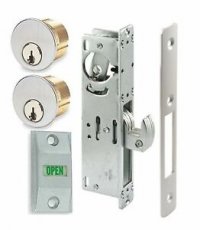1010.1.9.4 Bolt locks. Manually operated flush bolts or
surface bolts are not permitted.
Exceptions:
1. On doors not required for egress in individual
dwelling units or sleeping units.
2. Where a pair of doors serves a storage or
equipment room, manually operated edge- or
surface-mounted bolts are permitted on the
inactive leaf.
3. Where a pair of doors serves an occupant load
of less than 50 persons in a Group B, F or S
occupancy, manually operated edge- or surface-
mounted bolts are permitted on the inactive
leaf. The inactive leaf shall not contain
doorknobs, panic bars or similar operating
hardware.
4. Where a pair of doors serves a Group B, F or S
occupancy, manually operated edge- or surface-
mounted bolts are permitted on the inactive
leaf provided such inactive leaf is not
needed to meet egress capacity requirements
and the building is equipped throughout with
an automatic sprinkler system in accordance
with Section 903.3.1.1. The inactive leaf shall
not contain doorknobs, panic bars or similar
operating hardware.
5. Where a pair of doors serves patient care
rooms in Group I-2 occupancies, self-latching
leaf is not needed to meet egress capacity
requirements and the inactive leaf shall not
contain doorknobs, panic bars or similar operating
hardware.
1010.1.9.5 Unlatching. The unlatching of any door or
leaf shall not require more than one operation.
Exceptions:
1. Places of detention or restraint.
2. Where manually operated bolt locks are permitted
by Section 1010.1.9.4.
3. Doors with automatic flush bolts as permitted
by Section 1010.1.9.3, Item 3.
4. Doors from individual dwelling units and
sleeping units of Group R occupancies as permitted
by Section 1010.1.9.3, Item 4.
1105.1 Public entrances. In addition to accessible entrances
required by Sections 1105.1.1 through 1105.1.7, at least 60
percent of all public entrances shall be accessible.
Exceptions:
1. An accessible entrance is not required to areas not
required to be accessible.
2. Loading and service entrances that are not the only
entrance to a tenant space.
1109.13 Controls, operating mechanisms and hardware.
Controls, operating mechanisms and hardware intended for
operation by the occupant, including switches that control
lighting and ventilation and electrical convenience outlets, in
accessible spaces, along accessible routes or as parts of
accessible elements shall be accessible.
Exceptions:
1. Operable parts that are intended for use only by service
or maintenance personnel shall not be required
to be accessible.
2. Electrical or communication receptacles serving a
dedicated use shall not be required to be accessible.
3. Where two or more outlets are provided in a kitchen
above a length of counter top that is uninterrupted
by a sink or appliance, one outlet shall not be
required to be accessible.
4. Floor electrical receptacles shall not be required to
be accessible.
5. HVAC diffusers shall not be required to be accessible.
6. Except for light switches, where redundant controls
are provided for a single element, one control in
each space shall not be required to be accessible.
7. Access doors or gates in barrier walls and fences
protecting pools, spas and hot tubs shall be permitted
to comply with Section 1008.1.9.2.

